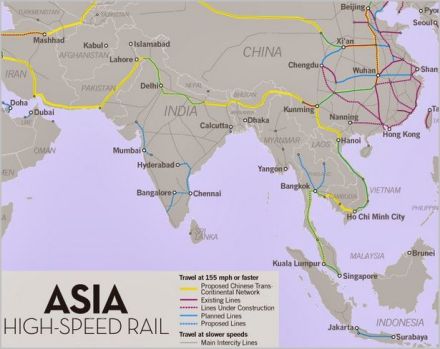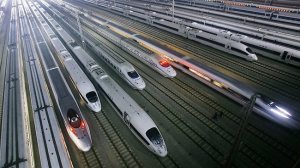Thailand’s ruling junta approves China rail links worth $23bn
Friday 1 August 2014
By Kate Hodal

Thailand’s ruling junta has approve
- a $23 billion (£13.6bn) transport project that will see two high-speed railways link up directly withChina by 2021, in a move seen as a further consolidation of Chinese power in the region. The National Council for Peace and Order … unveiled plans this week connecting the northern border town of
- Nong Khai with Map Ta Phut, located south-east of Bangkok.
- Chaing Khong, just south of the Laos capital Vientiane, will also be connected to Ban Phachi, in the central Ayutthaya regions. The railway lines will link up
- directly to Kunming, in China’s southern Yunnan province, in what analysts have termed Chinese „high-speed railway diplomacy„. China is looking to build a 3,000km high-speed line
- from Kunming all the way down to Singapore, passing through Laos, Thailand and Malaysia — a project that would increase China’s GDP and those of the involved nations by $375b, a former Chinese railway chairman told the China Daily. According to China Railway Corp, it appears the Kunming-Singapore line will be constructed in four stages,
- from Kunming to Vientiane, Vientiane to Bangkok, Bangkok to Kuala Lumpur, and Kuala Lumpur to Singapore.
CONSTRUCTION OF THE THAI LINES
- is planned to begin next yearas part of the new eight-year
- 4 billion baht ($23.3bn) infrastructure development project connecting Bangkok and other key cities with airports, seaports, border areas and cargo depots, the Bangkok Post reported, with some 106 new trains added to the existing fleet.
- Six dual-track railway lines will also be constructed under the same scheme. The two routes comprise nearly
- 1,400km in total but unlike many other high-speed trains, which generally run at a speed of 200 km per hour, will only be able to run at
- 160 km per hour until further investment would allow a higher-speed system…
Now the military government has approved the project, „there will be huge room for cooperation [between China and Thailand],“ Yang Yong of the China Railway Corp told China Daily, adding that Chinese engineers had been involved in feasibility research for the high-speed lines, and Chinese companies were directly helping to modernise Thailand’s railway system.
The effect of high-speed rail is likely to change South-east Asia and the way it does business for goods, says Geoff Wade of the College of Asia and the Pacific at the Australian National University. „When the people of the mainland countries soon find, through the convenience of [high-speed railways], that Kunming is their ‚closest neighbour‘ but a few hours away, the Yunnan capital will gradually emerge as the hub of the Greater Mekong Region and will eventually become, in effect, the capital of mainland Southeast Asia,“ Wade wrote on the Australian Strategic Policy Institute Blog.
Changing Asia: China’s high–speed railway diplomacy
2 Dec 2013
By Geoff Wade
‘HIGH-SPEED RAILWAY DIPLOMACY’
is used to describe the mechanisms by which China’s burgeoning capacities in high-speed railway (HSR) construction are being used in China’s international relations. The speed at which China has mastered HSR technology is unparalleled. Beginning with the import of technologies only in 2003, China began operating the Beijing-Tianjin HSR by 2008. In that same year, it built a train capable of a speed of 350 kilometres per hour.
Today the country boasts
- the greatest length of HSR track in the world (over 10,000 kilometres of rail capable of carrying trains at speeds in excess of 200 kilometres per hour). Further, China South Locomotive and Rolling Stock Corporation Limited (CSR) has achieved
- global records in terms of speed, with tests reaching 600 kilometers per hour. The scope of the system can be gleaned from the fact that in less than 2 years the HSR line linking
- Beijing and Shanghai recorded over 100 million passenger trips, while the Chinese government plans to
- invest over US$100 billion in railway construction this year.
China’s new and relatively cheap expertise in this technology is being promoted as both an economic and diplomatic tool…A 1,700 kilometre high-speed track will connect Lanzhou to Urumqi in Xinjiang (8 hours) from 2014, and this is intended for extension to Central Asia, while the Shanghai-Kunming route is slated to open in 2016. When completed, trains will take but 8 hours to cover the more than 2,000 kilometres between these two cities.
Longer-term plans are afoot to drive an HSR route
- from Kunming into India and then through Pakistan to Teheran. It’s from the Kunming hub that the high-speed rail system will
- route into mainland Southeast Asia, and it’s in this region that China’s HSR will be a strategic game-changer. As part of Thailand’s massive plans to upgrade its transport infrastructure, China is offering support through provision of HSR technology. Of the
- four Thai routes planned, the main one will be
- the northeast line, from Bangkok to Nong Khai, which will continue through Laos to Kunming. This route is planned to be functional by 2020…
‚Made in China‚ high–speed trains going global | Asia | DW
Other HSR routes connecting Kunming and mainland Southeast Asia cities are also being planned. A connection between Kunming and the Laotian capital of Vientiane was the subject of a 2010 memorandum and, while feasibility plans are still being conducted, the plan remains ‘on track’.) A high-speed line Kunming to Yangon was also proposed in 2010 and discussions are apparently ongoing. HSR routes connecting Kunming to Vietnam and to Cambodia have also been mooted and are seen as part of a ‘Pan-Asian railway’ project. A conventional railway from Kunming to Mengzi is being extended to the Vietnamese border and will eventually connect to Hanoi, completely replacing the narrow-gauge railway service which was discontinued in 2003…
As was foreshadowed several years ago,
connectivity between mainland Southeast Asia and southern China
is growing much faster than intra-ASEAN connectivity,
and the strategic geography of East Asia is thereby being changed forever. Driven by the high-speed rail networks,
new roads and telecommunication facilities centring on Kunming,
together with China’s burgeoning economic engagement
—both trade and investment—
with the Greater Mekong area,
mainland Southeast Asia is in the process of disconnecting from maritime Southeast Asia. This will, almost inevitably, result in ASEAN dividing along this fault line.
And when the people of the mainland countries soon find, through the convenience of HSR, that Kunming is their ‘closest neighbour’ but a few hours away,
the Yunnan capital will gradually emerge as the hub of the Greater Mekong Region and will eventually become, in effect, the capital of mainland Southeast Asia
Geoff Wade is a visiting fellow at the College of Asia and the Pacific, Australian National University.
Kunming–Singapore Railway – Wikipedia
Geopolitical ripples from Thailand’s …
Nikkei Asian Review
July 18, 2014
By Thitinan Pongsudhirak
Thailand’s May 22 military coup has generated striking geopolitical divides across the globe, as seen in the range of responses, from Washington and Beijing to Southeast Asian and European capitals and beyond.
- Western powers, particularly the U.S., have roundly condemned the putsch and exhorted Thailand’s military authorities to urgently protect human rights and restore democratic rule. But
- Asian governments – with notable exceptions such as Tokyo’s expression of „grave concern“ and similar cautions from Jakarta and Manila – have largely viewed the military intervention with a business-as-usual blind eye.
At issue in the fallout from Thailand’s coup is
- the geopolitical rivalry between the U.S. and China, and the broader
- prospect of democratization in developing Asia. If Thailand’s democratic setback entrenches authoritarian rule, it may reinforce the retreat of democracies elsewhere and boost China’s regional role while reinforcing a top-down governance approach at home…
Apart from the suspension of the $4.7 million IMET program, Thailand was abruptly excluded from the recent
- S.-led Pacific Rim naval exercise, known as Rimpac. Even
- Cobra Gold, the annual multinational defense exercise that is the bedrock of Thai-U.S. military relations, was suddenly put in limbo…
( THE 1833 TREATY OF AMITY AND COMMERCE SET OFF THIS RELATIONSHIP…THE UNITED STATES… GRANTED GENEROUS FINANCIAL AND MILITARY AID TO THAILAND IN THE CONTAINMENT EFFORTS AGAINST COMMUNISM DURING THE COLD WAR.
IN 1982, THE THAI AND U.S. FORCES COMMENCED ANNUAL JOINT TRAINING EXERCISES “COBRA GOLD”… (THAILAND CURRENTLY HOSTS APPROXIMATELY 60 U.S.-LED MILITARY EXERCISES ANNUALLY THROUGH THE COBRA GOLD SERIES)…
THE SECURITY ALLIANCE IN THE MODERN ERA IS GOVERNED BY TWO CORE AGREEMENTS:
- THE 1954 MANILA PACT AND THE 1962 THANAT-RUSK COMMUNIQUÉ. THE MANILA PACT HAS ITS ROOTS IN THE COLD WAR AND INVOLVED EIGHT COUNTRIES—AUSTRALIA, FRANCE, GREAT BRITAIN, NEW ZEALAND, PAKISTAN, THE PHILIPPINES, THAILAND AND THE UNITED STATES—AND WAS COMMITTED THROUGH THE SOUTHEAST ASIA TREATY ORGANISATION (SEATO), A SUPPOSEDLY IDENTICAL TWIN OF THE NORTH ATLANTIC TREATY ORGANISATION (NATO), TO STEM COMMUNIST EXPANSION. SEATO WAS EVENTUALLY DISSOLVED IN 1977 BUT
THE MANILA PACT PROVISIONS COMMITTING THE UNITED STATES TO PROTECT THAILAND FROM COMMUNISM REMAIN IN FORCE.
- THE THANAT-RUSK COMMUNIQUÉ EXPANDED THIS UNDERTAKING. IT WAS SIGNED BY THAI FOREIGN MINISTER THANAT KHOMAN AND HIS AMERICAN COUNTERPART DEAN RUSK.
IT PLEDGED EACH COUNTRY TO COME TO THE OTHER’S AID IN THE EVENT OF ANY EXTERNAL ATTACK.
THESE HAVE UNDERPINNED WASHINGTON’S MILITARY SUPPORT TO BANGKOK THROUGH ARMS, TRAINING AND EDUCATION…
THE TWO AGREEMENTS HAVE EQUALLY BENEFITED THAILAND AND THE UNITED STATES. ON THE THAI PART, THE KINGDOM GAINS MOST FROM THE ACCESS TO TRAINING AND EXERCISES ESSENTIAL TO PROFESSIONAL DEVELOPMENT OF THE ARMED FORCES. )
As Western responses lined up against the coup, Thailand’s junta looked to Asian neighbors for recognition and support. Looming large among Asian responses was the reaction from China. Although Thailand is not China’s formal ally, Beijing is as diplomatically and geopolitically close to Bangkok as any great power. Thailand has benefited over the centuries as if it were China’s next-door neighbor, despite the lack of a common border with the Asian giant. The Chinese government recognized Thailand’s latest coup, as it did the earlier putsches in Bangkok, within three working days…Beijing has remained a close and supportive partner also at times when Thailand’s democratic rule prevails. The Chinese have found ways to be Thailand’s all-weather friend…
For Beijing, Thailand is now a pivotal country in its geostrategic outlook.
Myanmar’s opening and reforms since 2011 have eroded Chinese dominance in that country, and just across Thailand’s eastern border, Cambodia’s see-saw election in July 2013 weakened the pro-Beijing regime of Prime Minister Hun Sen. In the maritime domains – both vis-a-vis Japan in the east and the Philippines and Vietnam in the south – China’s assertive territorial claims are fiercely contested, with the U.S. military presence constraining Beijing’s unilateral actions…
IF CHINA’S SOUTHERN MARITIME FLANK IS UNSTABLE, ITS SOUTHERN MAINLAND TIP MUST BE SECURED.

Thailand is thus a key piece of China’s geostrategic jigsaw puzzle. Much of what happens on Asia’s geopolitical canvas will depend on how the Thai coup plays out. If genuine democratic rule is restored after a period of pervasive and systematic militarization, Thailand may regain its geopolitical balance. But if authoritarianism solidifies at the expense of democratic legitimacy, Thailand may be forced to increasingly lean on Beijing for regime support and a geopolitical lifeline.
As democratization and geopolitics are increasingly entwined on Thailand’s horizon, Asian democratic voices are needed to nudge the country toward a geopolitical balance and a democratic future. While Philippine and Indonesian leaders demonstrated their democratic instincts at the outset, discreetly conveying their mild disapproval of the coup, other Asian democratic governments, particularly South Korea and India, could make a big difference by taking a similar stand. This would ultimately play into their geostrategic interests by encouraging China to play by the rules in order to deepen regional institutionalization and architecture-building…
Thitinan Pongsudhirak teaches international political economy and directs the Institute of Security and International Studies at Chulalongkorn University in Bangkok.



Hat dies auf "Globalisierung zähmen und die Früchte ernten." rebloggt.
LikeLike